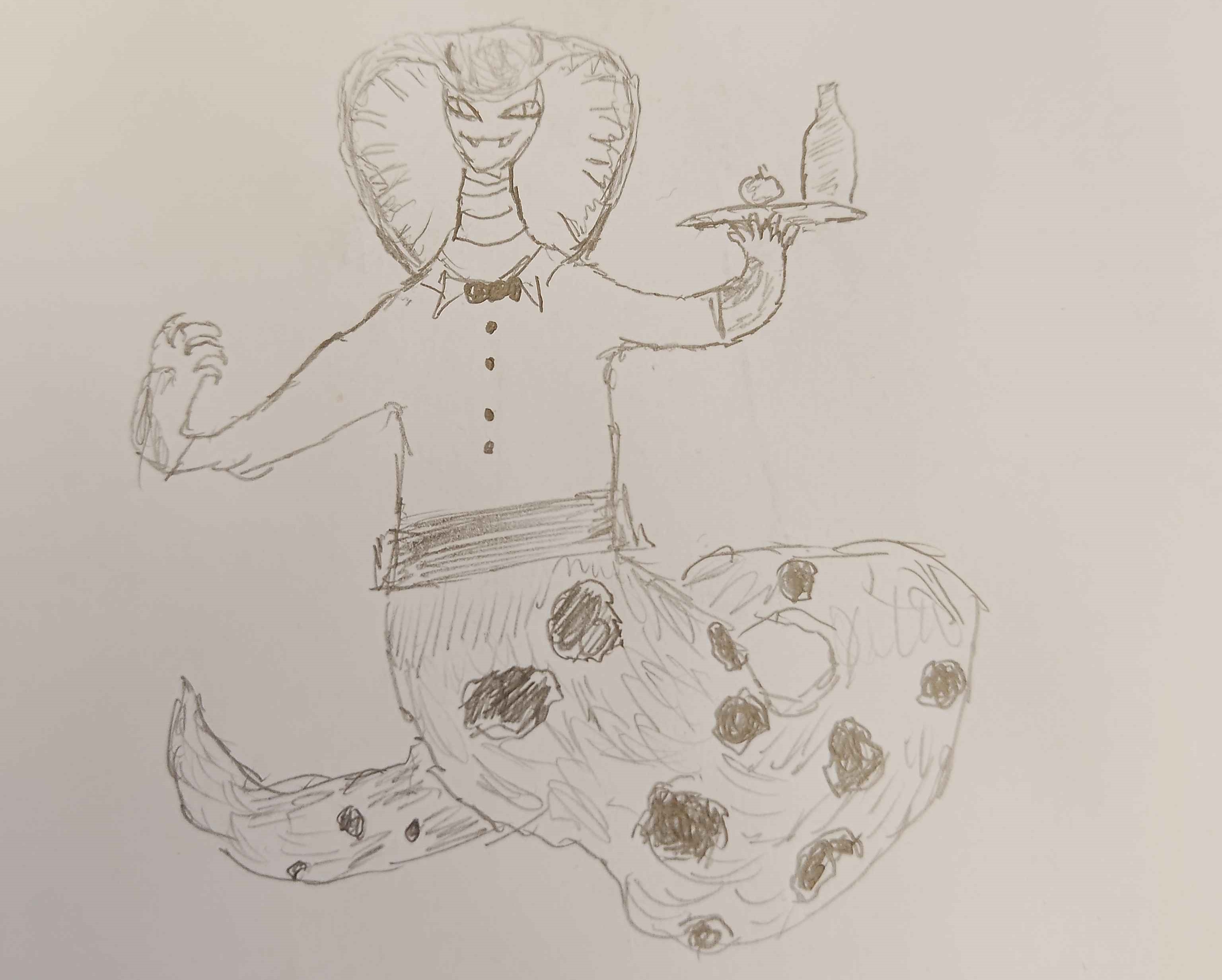Nagas
Nagas are a sapient serpentine species with reptilian arms and claws. They are known for their prowess in spellcasting, architecture, and stonework. They inhabit primarily the northern jungles and deserts of Meibor, preferring warmer climates. Nagas are known to be sociable, often preferring groups to solitude. Their unique body shape mean that naga structures use slides and curved areas often in their architecture.

Nagas
Population: 56 Million
Average Lifespan: 80 years
Size: 1.5 - 2.1 meters
Rarity: Common
Physical Characteristics
Nagas are distinguished by their serpentine lower bodies and torsos with arms and claws.
Their heads resemble that of cobras with forked tongues They move by slithering on the ground with their large, powerful tails, as they have no legs.
Their scales range in color, with green and blue tones being most prevalent, though rare variants like orange and indigo exist.
Nagas have many traits of their serpentine ancestors, being cold blooded and egg laying.
While they aren't entirely carnivores, nagas prefer a meat-heavy diet.
Stereotypically, nagas are known to care deeply about their appearance, often polishing or dyeing their scales and being fond of jewelry and fashion.
Many nagas like to stay in the sun, even if they cannot tan like humans.
Nagas average between 1.5 and 2.1 meters in height when standing, though their bodies are longer when measured from snout to tail end.
Society and Culture
Community Structure
Power in naga society is both hereditary and meritocratic. Like humans, many naga communities have nobles and kings who gain their roles through lineage. However, naga societies also provide opportunities to rise in rank through skills and deeds, with a focus on magical prowess. Nobles receive better education and possibilities, but if a commoner surpasses them, they are believed to have earned a rank among them. Outsiders sometimes call naga politics ruthless and cutthroat, but they believe them fair and adaptive. Traditionally, the nagas had few democracies, due to a belief in strong central power.
Settlements
Naga cities are known for their impressive stone architecture, featuring multi-level designs with numerous bridges and overpasses. These cities are built to harmonize with their natural environments, often incorporating local flora into their urban landscapes. Nagas are adept builders, responsible for many of Ishyin's spires and various palatial structures across different kingdoms. Naga buildings also take their unique shape into account, featuring ramps and pillars instead of stairs and ladders. Naga who live among others for long periods often modify their homes to suit their shape.Economy and Craftsmanship
Nagas excel in masonry and mining, providing the foundation for their strong economy.
They trade extensively with neighboring species, especially the yirte, exchanging metals and stonework for potions and crops.
Their craftsmanship extends to creating intricate stone monuments and durable roads and structures, which are renowned throughout their regions.
Hunting was for a long time important in naga society, but its importance has diminished due to overhunting, logging of the jungles and increased animal husbandry.
Religion and Beliefs
Most nagas don't follow an organized religion but have a large number of minor deities and spirits connected to various regions and concepts. Their beliefs vary from city to city and often involve small temples and shrines instead of larger buildings.
Daily Life and Practices
Education
Education in naga society is heavily focused on wizardry and magical arts. The prestigious Ishyin Academy, founded by nagas, stands as a testament to their commitment to magical education. Naga children are often trained in spellcraft from a young age, with many pursuing advanced magical studies. Especially in noble circles, magical education is important with many looking down on those with no magical ability.
Art and Music
Naga art and music are deeply intertwined with their magical practices. Their art often features intricate stone carvings and sculptures, while their music incorporates mystical tones and rhythms, sometimes used in spellcasting rituals.Interaction with Other Species
Yirte
Naga relations with the yirte have fluctuated between conflict and cooperation throughout history. Currently, most naga nations maintain a peaceful trade relationship, importing yirte potions and food in exchange for naga metals and stonework.
Dragonkin
As the only reptilian sapients, naga and dragonkin have a connection. Naga-Dragonkin relations have been historically shaky however as some naga see dragonkin as stiff and stuck up and the Draconium sees them as fleeting and unprofessional.Other Species
The breach has brought an influx of humans, gnomes, and other species to naga lands, leading to new minority populations in countries like Theze.Military and Defense
Naga military forces are primarily composed of skilled mages and armed warriors. Naga armies focus on strategies where spellcasters deal with enemies while warriors protect them from harm. While not as skilled as the yirte, nagas are adept at ambush tactics in jungles and deserts. Their defensive strategies often leverage their architectural knowledge, using fortified cities and strategic choke points. Nagas also employ various magical defenses, making their strongholds particularly difficult to penetrate. Due to their unique body shape nagas have little cavalry.
Magic
Nagas are renowned for their expertise in wizardry. They are especially adept at individual spellcraft, and sometime look down on artifice as a lesser form of magic. Their magical abilities are diverse, but they are particularly skilled in enchantments and elemental magic, which they use both in combat and in the construction of their cities.